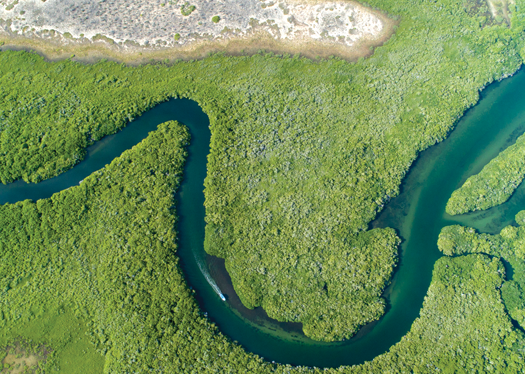
Drone shot of mangroves in Baja California Sur, Mexico. (Photo by Octavio Aburto)
A recent study on mangrove destruction in Mexico underscores the importance of getting the greatest climate-protection bang for each forest-conservation buck.
Mangrove forests can store far more carbon per hectare than tropical forests, and currently they provide 3% of world carbon sequestration overall, notes the study, published in April in the scientific journal Ambio. If mangrove clearing continues unabated, the authors argue, their loss therefore will cause disproportionately large increases in carbon emissions and, as a result, social costs.
The research team, led by scientists from the Scripps Institution of Oceanography and the University of California, Riverside, determined that Mexico lost mangrove forest at an average annual rate of 0.43% during 2005-15. If this pace were to continue for the next 25 years, they calculate, the resulting carbon emissions would cause US$400 million in social costs over the period.
“Scale mismatch” seen
The findings underscore what the study’s authors call a “scale mismatch” in which carbon-emission mitigation policies are failing to prioritize mangrove-stand conservation “despite mangroves contributing disproportionally to global carbon sequestration.”
The researchers are hopeful Mexico’s government will take the findings into account as it updates its Nationally Determined Contributions (NDC), a voluntary greenhouse-emissions reduction plan that is required under the Paris Climate Agreement and is due to be renewed this year. In Mexico’s current NDC, drafted in 2015, only one sentence is dedicated to mangrove conservation.
“It is very critical that mangroves are not just mentioned in the NDC, but that a detailed plan is included about how the country is going to support mangroves for climate change mitigation and adaptation,” says Joy Kumagai, the study’s lead author.
Kumagai says that in estimating the future “social costs” of mangrove losses, the study did not factor in numerous benefits that mangroves provide—for instance, providing nursery habitat for fish or buffering coastal areas from hurricanes. “The true value of mangroves being lost is much higher than the $400 million estimate, but this study is focused solely on carbon stocks and carbon sequestration,” Kumagai said. “Mangroves produce so many more benefits.”
The study examined 175 Mexican coastal municipalities where mangrove forests are located and sorted them into four regions—the Mexican Caribbean, Gulf of California, Mexican Pacific and Gulf of Mexico. Researchers found that municipalities located along the Gulf of Mexico had the greatest mangrove deforestation both in absolute and relative terms since 2005, with 5,272 hectares (13,027 acres) destroyed in the 10-year span, or an average annual loss of 0.615%. Kumagai notes that hurricanes contributed to the losses during the observation period. The Mexican Caribbean had the lowest mangrove loss during the period, with 945 hectares (2,335 acres), or an annual average of 0.227%.
Calculating the cost
To estimate carbon-sequestration losses as a result of the deforestation, the researchers calculated the carbon per unit in aboveground biomass, below-ground biomass, soil, and litter in each of the 175 municipalities.
With these estimates in hand, they projected the social cost that would be imposed by the additional carbon that would enter the earth’s atmosphere if Mexican mangrove destruction were to continue at the current rate over the next 25 years. They also estimated the cost of the “prevented carbon sequestration” brought about by the mangrove loss.
In both cases, they applied the social cost of carbon (SCC), which is an estimate of the marginal cost of all future damage done by a pulse of one ton of carbon into the atmosphere.
“The premise is that we decided on a study that examines the next 25 years,” Kumagai says. “We extended the deforestation rate, we quantified the damages from the release of carbon stocks and prevention of carbon sequestration, and then we figured out how much that would be in current value.”
The study concludes that the average estimated climate-related cost of destroying a hectare of mangroves in Mexico is $21,000.
“If the baseline deforestation rate continues for 25 years, total damages to society would be $385-$400 million,” the study found. “Per municipality total damage would range from $0 to $81.5 million with an average of $2.2 million.”
The researchers developed a prioritization model that recommends where conservation efforts should be focused to curb future mangrove deforestation rates. The study concluded that if Mexico prioritized mangrove conservation and halted deforestation in 26 of the 175 municipalities, 50% of the estimated $400 million in damages could be avoided.
“Bridging the gap between research and governmental action using local initiatives will be paramount for the effective management of mangrove carbon,” the study says.
- Adam Williams